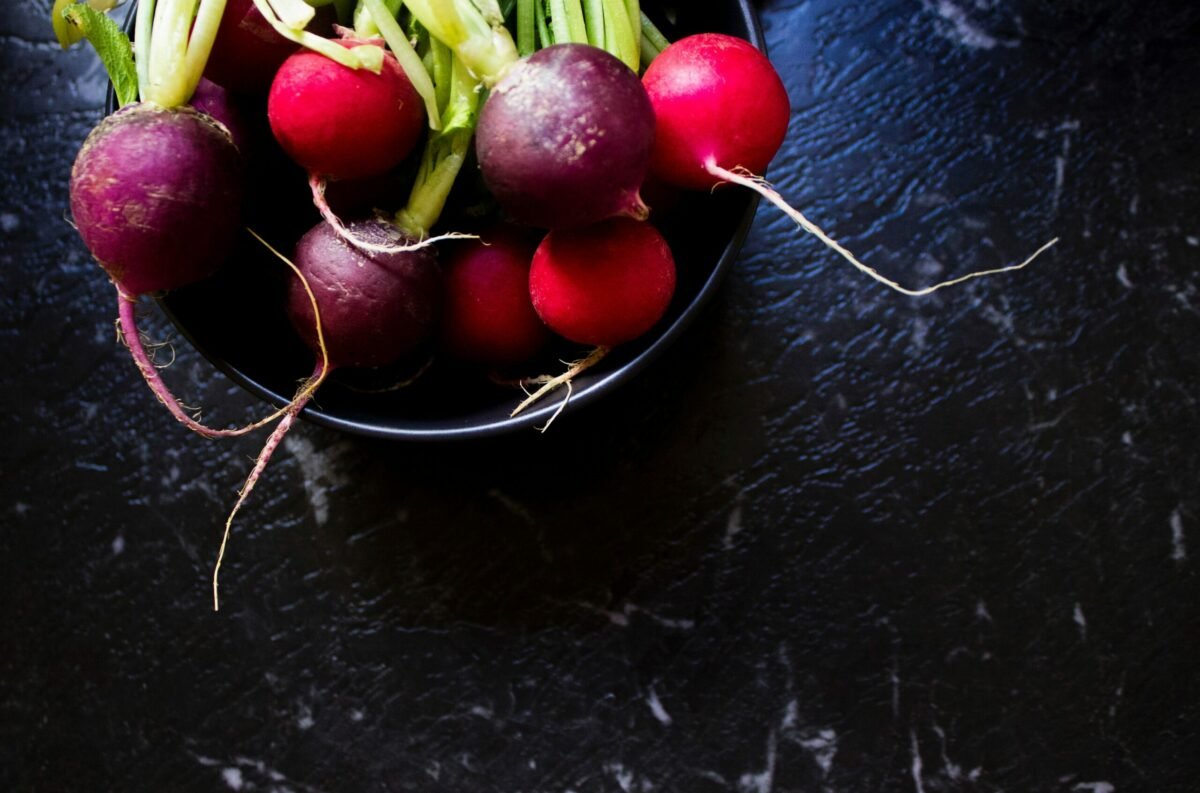We're an affiliate
We hope you love the products we recommend! Just so you know, we may collect a share of sales or other compensation from the links on this page at no additional cost to you. Thank you if you use our links, we really appreciate it!
As a responsible dog owner, it is best to ensure your pup gets proper nutrition by providing a balanced wholesome diet.
While dogs have specific dietary requirements, it is okay to wonder if they can enjoy some of the same foods we do.
Keep reading this article as we explore the safety concerns of radishes for dogs as food, their nutritional profile, potential benefits, and associated risks.
Watch out for our section on how best to incorporate these crunchy vegetables in your dog’s diet, without exposing them to side effects.
Nutritional Value of Radishes
Most people know radishes as the small root vegetable of the Brassicaceae family, but little is known about their nutritional value.
The small edible root bulb of this veggie comes in various shades of red, purple, or yellow, but the interior fleshy part is always white. Radishes have a crunchy texture and distinctive spicy flavor.
Talking of nutritional value, radishes are loaded with essential vitamins including vitamins C, B6, and E, in addition to a host of other nutrients.

Vitamin C takes up a huge chunk of radishes’ nutritional profile at about 24% of the nutrients. This is particularly good for building your dog’s immunity against diseases.
Some of the other common nutrients found in these crunchy vegetables are calcium, potassium, magnesium, dietary fiber, and some bits of proteins.
It’s also important to note that radishes are a low-calorie vegetable, which makes them a good option for supplying nutrients to your pup without adding too much sugar.
Are Radishes Safe for Dogs?
The short answer is yes! Radishes are safe for dogs but only when given in moderation. These crunchies are loaded with essential vitamins and minerals which can be beneficial to your dog.
Some dogs will take a bit of time to appreciate the taste of these root vegetables, while others may find the spicy flavor a bit odd for their taste buds.
Radishes are best given to dogs when peeled and in small amounts. It’s important to monitor your dog’s reaction to the flavor before increasing the amount they consume.
Despite the potential gains of feeding radishes to dogs, pet parents should be aware of certain risks including choking hazards especially when dogs eat the whole bulb.
It’s important to note that there are two plants with the suffix name ‘radish’ that are actually not radishes and are also not safe for dogs to eat.
Wild radishes and horseradish are categorized as toxic for dogs due to the large amounts of isothiocyanate which cause a burning sensation when ingested.
6 Health Benefits of Radishes for Dogs
Dogs may benefit from eating small amounts of radishes from time to time, thanks to their nutritional composition.
The following are some of the health benefits your dog may enjoy when snacking on small pieces of radishes:
1. Supports the immune system
Radishes are loaded with 14.8 mg of vitamin C in every 100 grams of fruit. Vitamin C can play a crucial role in building the dog’s immunity against communicable diseases.
Vitamin C can also serve as an antioxidant to neutralize the harmful free radicles in the body and prevent chronic inflammation.
2. Improves digestion
Radishes are packed with dietary fiber which helps to support healthy digestion in dogs, regular bowel movements, and preventing constipation.
A few slices of these root veggies topped on your dog’s regular meal can also help them feel full, thanks to the fiber content.
3. Support cardiovascular health
Potassium in radishes, which is estimated to be around 233 mg per 100 grams of the fruit, can help to support the dog’s muscular and cardiovascular health.
This essential mineral works by keeping the heartbeat steady and lowering the blood pressure in dogs by easing tension in the blood vessels.
4. Improves dental hygiene
The dry and rough texture of raw radishes can improve your dog’s dental hygiene by scrapping off plaque from the enamel when chewing.
You can feed this crispy treat to your dog between meals to freshen their breath and clean their teeth.
5. Improves hydration
Radishes are high-water root vegetables, which help in keeping your dog hydrated, especially during the warmer months.
Hydration is crucial in dogs because it helps the body’s organs to function at maximum and reduces the risk of certain chronic infections.
6. Low calories
Furthermore, the low-calorie and low-fat content of radishes makes them a suitable snack option for overweight dogs. They can be a healthy and satisfying snack that won’t contribute to weight gain.
Risks And Precautions when Feeding Radishes to Dogs
There’s no doubt that radishes can provide a satisfying crispy taste to your dog while offering additional nutrients without adding excess calories to their diet.
But, it’s also important to exercise caution with moderation when feeding your dog this veggie to avoid the associated risks.
Some of the potential risks you need to watch out for are:
1. It can be too spicy for some dogs
Some dogs may find the taste of radishes to be too spicy for their taste buds.
The peppery taste of radishes may become overly pungent when they grow in hot weather or get harvested past the maturity date.
Dogs who find the taste to be too spicy may have trouble digesting raw radishes and this can lead to a burning sensation and gastrointestinal upset when ingested.
2. Choking hazard
Dogs may risk getting choked when they eat large pieces or whole radishes.
As a precaution to this risk, we advise pet parents to peel and cut radishes into smaller sizes before feeding them to their pups.

3. Allergies
Some dogs can develop a negative reaction after eating a few pieces of raw or cooked radish. Such reactions may manifest as itching, swelling, or gastrointestinal issues such as bloating.
To mitigate your dog from suffering adverse reactions, you should introduce new foods to them by offering a tiny taste and observing their reaction for the next couple of hours.
If your pooch seems to be fine after eating a small piece of radish within a few hours, then you can clear them and serve this occasional treat once in a while.
As a general precaution, it is always a good idea to offer your dog a fresh piece of organically grown radish free from pesticides.
Dogs should never consume seasoned radish since it may aggravate their sensitivities and cause a negative reaction.
How To Prepare Radishes for Dogs In 4 Simple Steps
If you’ve decided to introduce radishes to your dog, we recommend preparing them in a mouthwatering way to entice your pup for a bite.

You should not give a whole radish to your dog since it may cause choking.
Step 1: First, you need to choose the right type of radish before cutting it up for your dog.
We recommend going for the organically grown red radishes which are moderately ripe since they are less spicy and less pungent to dogs.
Step 2: The second thing is to discard the radish greens, then wash thoroughly with clean running water. The radish greens can irritate your dog’s stomach, so it is best to avoid it altogether.
Step 3: Use a vegetable peeler to peel off the skin from the red radish bulb and remove all surface blemishes before chopping it on a board.
Step 4: Once peeled, use a sharp knife to cut down the radish on a chopping board into smaller pieces, ideal for your dog’s age and size.
Since this vegetable is best eaten when freshly cut, make sure to give your dog a few slices immediately.
Alternatively, you can grate a peeled radish bulb and top it on your dog’s kibbles of wet foods to spice up the taste and add extra texture.
You can also steam your sliced radishes to make it easier for dogs with sensitive stomachs. Be cautious not to overcook the radishes because too much heat can destroy the nutritional content.
Steaming is also a creative way of enhancing the taste and aroma of radish, but make sure not to add salt or seasoning since it may overwhelm your dog’s digestion.
How to Introduce Radishes to Your Dog’s Diet
Based on your chosen method of preparing radishes for your dog, you can introduce this savory treat slowly and gradually to ensure your dog’s health.
As always, we suggest speaking to your vet before introducing new diets, especially human foods, to your dog.
To introduce this crunchy vegetable to your dog, start by offering a small slice, or grated radish as a treat or topping on your dog’s regular meals.
Offering a small bite is a precautionary measure that allows you to monitor your dog’s response to the new food and minimize the extent of negative reactions, if any.
After your furry friend eats up the small portion, you should observe their response over the next few hours for any signs of digestive upset or allergic reaction.
If your dog has no problem with radishes, you can increase the amount over time while observing the limits for optimum health.
However, if your dog finds the flavor to be off-putting, you can try altering the recipe or offer them an alternative dog-safe fruits or vegetable altogether. Never force your dog to eat foods against their wishes.
Signs of Allergic Reactions or Digestive Issues
As we mentioned earlier, it’s important to observe your dog’s immediate reaction after consuming radishes to observe the signs of allergic reactions and digestive issues.
Some dogs may not show any negative reactions immediately, so it’s important to also keep a close eye on long-term effects.
Some of the most common symptoms of adverse reactions to radishes in dogs are skin irritation, itchiness, swelling, difficulty breathing, and gastrointestinal problems.
The common symptoms of digestive issues among dogs with sensitivities to radishes include; gas, bloating, vomiting, diarrhea, and stomach cramps.
The crunchiness of radishes can be overwhelming to some dogs with soft mouths and they can be abrasive to their teeth and gums to cause oral irritation.
If you notice any sign of negative effects on your dog after offering them radishes, you should discontinue the veggie immediately and call your vet for professional advice.
Some of these symptoms may not be exclusively caused by radishes, so it’s important to visit the vet’s office for proper diagnosis and treatment.
11 Other Veggies Safe for Dogs
If you’re looking for more creative ways to spice up your dog’s diet, here are some of the other vegetables you can try:
1. Broccoli
Broccoli is packed with a huge variety of vitamins, such as vitamin A, C, K, and minerals such as potassium, which improve bone health, prevents diseases, and improve heart health in dogs.
2. Butternut
Butternut squash is loaded with lots of vitamins and minerals such as vitamins A, C, B6, and more which help to improve the immune system in dogs and improves vision and cardiovascular functions.
3. Carrots
Carrots are high in vitamin A (from the carotenoid – Beta Carotene), biotin, vitamin K, potassium, and vitamin B6. Feeding some carrot pieces to your dog helps improve vision.
4. Celery
Celery is a nutrient powerhouse of many vitamins such as A and C, which are antioxidants that will help prevent chronic inflammation and keep your dog healthy.
5. Cucumber
Cucumbers are choke-full of phytonutrients and antioxidants, which help to fight harmful radicals to keep your dog safe from inflammation and chronic illnesses.
6. Green Beans
Green beans are full of essential vitamins and minerals, such as iron, calcium, and vitamins B6, A, C, and K. Green beans are also rich in dietary fiber and low in calories, which can prevent constipation.
7. Peas
They are a rich source of plant-based protein, which helps in body-building and tissue repair. Peas also have good amounts of vitamins A, B, and K.
8. Pumpkin
Pumpkins are high in fiber and very low in calories, which can help your dog with digestive health while limiting sugar intake.
9. Spinach
Spinach contains minerals such as potassium, magnesium, and vitamins B6, B9, and E. This vegetable helps to improve your dog’s muscles and cardiovascular health while preventing inflammation.
10. Sweet potatoes
The high fiber content in sweet potatoes can help improve your dog’s digestive health. It also has provitamin A which is great for your dog’s eye health.
11. Zucchini
Zucchini is a nutritional powerhouse with lots of phytochemicals, antioxidants, vitamins, and minerals. Feeding your dog a few slices of zucchini can help counter inflammation in the body.
Frequently Asked Questions (FAQs)
1. How many radishes can a dog eat?
Adult dogs can safely have modest amounts of one or two medium-sized radish bulbs per serving, while puppies should not have more than one.
Since radishes should be served as occasional treats, you should limit the amount to not more than 10% of your dog’s daily diet.
2. Can radishes be given to dogs as treats?
Yes! Dogs can enjoy sliced or grated radishes as occasional treats rather than everyday rewards. It’s a low-calorie snack that packs lots of nutritional benefits for pups.
Make sure to use organically grown raw or cooked radishes, without adding spices, seasonings, or marinades.
3. How should I monitor my dog after giving them radishes?
You can monitor your dog by observing their behavior after consuming radishes and paying close attention to their bathroom habits.
You can also look for any signs of itching, or skin irritation, or inspect the dog’s coat with your fingers to check for swellings.
Conclusion
So, can dogs eat radishes? The good news is yes, dogs can eat radishes, but in limits as an occasional treat.
Modest amounts of peeled radishes can provide dogs with essential vitamins, minerals, and fiber, to support their overall health.
As with any other new food, pet parents should gradually introduce radishes with moderation since some dogs may not readily accept the peppery taste of these crunchies.
While a few slices of rads can be a nutritious addition to your dog’s meals, they should never replace the core components of their regular diet.
Always monitor your dog for any adverse reactions and consult with your veterinarian before making any significant dietary changes to your pup.
Laura is the founder of Furs'n'Paws. She is a also a pet writer and expert with more than 20 years of experience of working with dogs and cats. She developed a very strong love for animals at a young age. Her passion led her to establish a thriving pet sitting and dog walking business in Dubai. As an expert in pet training, behavior, and nutrition, Laura is committed to helping pet owners and pet lovers by offering high-quality information on a wide range of topics.



No responses yet